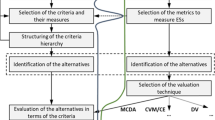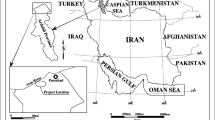Abstract
This article describes how options for managing dairy effluent on the Lower Murray River in South Australia were evaluated using multiple criteria analysis (MCA). Multiple criteria analysis is a framework for combining multiple environmental, social, and economic objectives in policy decisions. At the time of the study, dairy irrigation in the region was based on flood irrigation which involved returning effluent to the river. The returned water contained nutrients, salts, and microbial contaminants leading to environmental, human health, and tourism impacts. In this study MCA was used to evaluate 11 options against 6 criteria for managing dairy effluent problems. Of the 11 options, the MCA model selected partial rehabilitation of dairy paddocks with the conversion of remaining land to other agriculture. Soon after, the South Australian Government adopted this course of action and is now providing incentives for dairy farmers in the region to upgrade irrigation infrastructure and/or enter alternative industries.





Similar content being viewed by others
References
Adhikari M, Paudel KP, Martin NR Jr, Gauthier WM (2005) Economics of dairy waste use as fertilizer in central Texas. Waste Management 25:1067–1074
ABS (Australian Bureau of Statistics) (2001) Water Account Australia. ABS Catalogue No. 4610.0, Australian Bureau of Statistics, Canberra, 137 pp
ABS (Australian Bureau of Statistics). (2004). Year Book Australia. N umber 86. ABS Catalogue No. 1301.0, Australian Bureau of Statistics. Canberra, 872 pp
Beck MP, Lin BW (1983) Some heuristics for the consensus ranking problem. Computers and Operations Research 10: 1–7
Bennet J (2005) Australasian environmental economics: contributions, conflicts and cop-outs. The Australian Journal of Agricultural and Resource Economics 49: 243–261
Bodini A, Ricci A Viaroli P (2000) A multimethodological approach for the sustainable management of perifluvial wetlands of the Po River (Italy). Environmental Management 26: 59–72
Bojórquez-Tapia LA, Sánchez-Colon S, Martinez AF. (2005). Building Consensus in Environmental Impact Assessment Through Multicriteria Modeling and Sensitivity Analysis. Environmental Management 36(3): 469–481
Brans JP, Mareschal B (2005) Pages 163–195 in Figueira J., G. Salvatore, M. Ehrgott (Eds), Multiple Criteria Decision Analysis: State of the art surveys, Springer, New York
Brans JP, Vincke P, Mareschal B (1986) How to select and how to rank projects: The PROMETHEE method. European Journal of Operational Research 24: 228–238
Brouwer R, van Ek R (2004) Integrated ecological, economic and social impact assessment of alternative flood control policies in the Netherlands. Ecological Economics 50:1–21
Cassells SM, Meister AD (2001) Cost and trade impacts of environmental regulations: effluent control and the New Zealand dairy sector. Australian Journal of Agricultural & Resource Economics 45(2): 257–274
Cook WD, Kress M (1990) A data envelopment model for aggregating preference rankings. Management Science 36: 1302–1310
d’Angelo A, Eskandari A, Szidarovszky F (1998) Social choice procedures in water resource management. Journal of Environmental Management 52: 203–210
Demirel B, Yenigun O, Onay TT. (2005) Anaerobic treatment of dairy wastewaters: a review. Process Biochemistry 40: 2583–2595
DWLBC (Department of Water, Land, Biodiversity Conservation) (2003) Guidelines: New requirements and public financial assistance for irrigated agriculture in the Lower Murray Reclaimed Irrigation Areas. Department of Water, Land and Biodiversity Conservation, Government of South Australia, Adelaide, 3pp
Eder G, Duckstein L, Nachtnebel HP (1997) Ranking water resource projects and evaluating criteria by multicriterion Q-analysis: an Austrian case study. Journal of Multi-Criteria Decision Analysis 6: 259–271
Emond EJ, Mason DW (2002) A new rank correlation coefficient with application to the consensus ranking problem. Journal of Multi-Criteria Decision Analysis. 11: 17–28
EPA (Environmental Protection Agency) (2003) EPA Guidelines for Lower Murray Reclaimed Irrigation Areas. Environmental Protection Agency, Adelaide, South Australia, 5pp
Figueira J, Greco S, Ehrgott M (Eds) (2005) Multiple criteria decision analysis: State of the art surveys. Springer: New York; 1045 pp
Gershon M, Duckstein L (1983) Multiobjective approaches to river basin planning. Journal of the Water Resources Planning and Management Division 109: 13–28
Hajkowicz SA, McDonald GT, Smith PN (2000) An evaluation of multiple objective decision support weighting techniques in natural resource management. Journal of Environmental Planning and Management 43: 505–518
Hubble I, Phillips R (1999) Tasmanian dairy farm effluent management program. Journal of Cleaner Production 7: 167–168
Janssen R. (2001) On the use of multi-criteria analysis in environmental impact assessment in the Netherlands. Journal of Multi-Criteria Decision Analysis 10: 101–109
Joubert AR, Leiman A, de Klerk HM, Katau S, Aggenbach JC (1997) Fynbos vegetation and the supply of water: a comparison of multi-criteria decision analysis and cost benefit analysis. Ecological Economics 22: 123–140
Kasanen E, Wallenius H, Wallenius J, Zionts S (2000) A study of high-level managerial decision processes, with implications for MCDM research. European Journal of Operational Research 120: 496–510
Keeney RL, Raiffa H (1993) Decisions with multiple objectives: preferences and value tradeoffs, Second edition. Cambridge University Press, London, 569pp
Lahdelma R, Salminen R, Hokkanen J (2000) Using multiple criteria methods in environmental planning and management. Environmental Management 26: 595–605
LMIAG (Lower Murray Irrigation Action Group) (1999) Draft Land and Water Management Plan for the Lower Murray Reclaimed Swamp Irrigation Areas. LMIAG, Murray Bridge, South Australia, pp 53
Mardle S, Pascoe S, Herrero I (2004) Management Objective Importance in Fisheries: An Evaluation Using the Analytic Hierarchy Process (AHP). Environmental Management 33:1–11
Mendoza G, Prabhu R (2000) Development of a Methodology for Selecting Criteria and Indicators of Sustainable Forest Management: A Case Study on Participatory Assessment. Environmental Management 26: 659–673
Mingers J, Rosenhead J (2004) Problem structuring methods in action. European Journal of Operational Research 152: 530–554
Munda G (2005) In: Figueira J, Salvatore G, Ehrgott M, (eds), Multiple Criteria Decision Analysis: State of the art surveys, Springer, New York pp. 953–987
Ozelkan EC, Duckstein L (1996) Analysing water resource alternatives and handling criteria by multi criterion decision techniques. Journal of Environmental Management 48: 69–96
Prato T. (1999) Multiple attribute decision analysis for ecosystem management. Ecological Economics 30: 207–222
Raju KS, Duckstein L, Arondel C (2000) Multicriterion Analysis for Sustainable Water Resources Planning: A Case Study in Spain. Water Resources Management 14: 435–456
RMWRC (River Murray Water Resources Committee) (1995) River Murray Regional Water Resource Management Plan - Border to the Barrages and Beyond. River Murray Water Resources Committee, Berri, South Australia
Roy B. (1968) Classement et choix en présence de points de vue multiples (la méthode ELECTRE). la Revue d’Informatique et de Recherche Opérationnelle (RIRO) 8: 57–75
Saaty TL (2005) In: Figueira J, Salvatore G, Ehrgott M (eds) Multiple Criteria Decision Analysis: State of the art surveys, Springer, New York pp. 345–408
Scheubrein R, Zionts SA (2006) A problem structuring front end for a multiple criteria decision support system. Computers & Operations Research 33: 18–31
Seo F, Sakawa M (1988) Multiple criteria decision analysis in regional planning: concepts, methods and applications. Kluwer Academic, Boston, 535pp
Strijker D, Sijtsma FJ, Wiersma D (2000) Evaluation of Nature Conservation: An Application to the Dutch Ecological Network. Environmental and Resource Economics 16: 363–378
Vellidis G, Smith MC, Leibowitz SG, Ainslie WB, Pruitt BA (2003) Prioritizing wetland restoration for sediment yield reduction: a conceptual model. Environmental Management 31: 301–312
Weber M, Borcherding K (1993) Behavioural influences on weight judgements in multiattribute decision making. European Journal of Operational Research 67: 1–12
Weistroffer HR, Smith CH, Narula SC (2005) In: Figueira J, Salvatore G, Ehrgott M (eds) Multiple Criteria Decision Analysis: State of the art surveys, Springer, New York pp. 989–1018
Wheeler S, Young D, Bright M (2001) Consultancy for Lower Murray Reclaimed Irrigation Areas: Options study stage two. Volume 1. PIRSA Rural Solutions, Adelaide, 111 pp
Whittle J, Philcox M (1996) Drainage Management Options for the Lower Murray Reclaimed Swamps. Primary Industries South Australia, Adelaide
Willers HC, Karamanlis XN, Schulte DD (1999) Potential of closed water systems on dairy farms. Water Science Technology 39: 113–119
Zanakis SH, Solomon A, Wishart N, Dublish S (1998) Multi-attribute decision making: A simulation comparison of selected methods. European Journal of Operational Research 107: 507–529
Zeleny M (1973) In: Cocharane JL, Zeleny M (eds) Multiple criteria decision making, University of Southern Carolina Press, Columbia, S.C pp. 262–301
Acknowledgments
This study was funded by PIRSA (Primary Industries and Resources of South Australia). It formed part of a larger economic study into managing the LMRIA involving Doug Young, Melissa Bright, and Andrew Manson of PIRSA. The PIRSA team supplied valuable advice and assisted with the MCA work. We are much appreciative to the panel of 10 persons who provided input to the MCA. Follow-up advice on current progress in the LMRIA region was supplied by Graham Copley of the Department of Water Land and Biodiversity Conservation. We are also grateful for detailed review feedback from Andy Reeson and Ainsley Archer of CSIRO and Ron Janssen, Tony Prato, and two anonymous reviewers acting for the Journal.
Author information
Authors and Affiliations
Corresponding author
Rights and permissions
About this article
Cite this article
Hajkowicz, S.A., Wheeler, S.A. Evaluation of Dairy Effluent Management Options Using Multiple Criteria Analysis. Environmental Management 41, 613–624 (2008). https://doi.org/10.1007/s00267-007-9060-8
Published:
Issue Date:
DOI: https://doi.org/10.1007/s00267-007-9060-8




